Accumulation of Heavy Metals in Blueberry (Vaccinium myrtillus L.) and Dominant Mosses (Pleurozium schreberi (Willd. ex Brid.) Mitt.) as Bioindicators of the Expressway Influence on Forest Ecosystems
Abstract
:1. Introduction
2. Materials and Methods
2.1. Area of Study
- Stands “newly opened” to the impact of deposition—stands around strips cut for the construction of the S7 route, in use since 2009–2011 (5 plots; plots: no. 1–5);
- Stands under the influence of deposition for a long time—stands around strips cut for the construction of the S7 route in the 1970s (3 transects; plots: no. 6–8).
2.2. Sampling Scheme
2.3. Quality Control of the Obtained Measurement Results
2.4. Statistical Processing of Results
2.5. Geoaccumulation Index—Igeo
- C—current content of heavy metals in the top soil layer
- Bn—heavy metal content of the parent rock or geochemical background
- 1.5—represents the background scattering due to lithogenic variations
- ≤0: Not to weakly polluted;
- 0–1: Weakly to moderately polluted;
- 1–2: Moderately polluted;
- 2–3: Moderately to strongly polluted;
- 3–4: Strongly polluted;
- 4–5: Strongly to excessively polluted;
- ≥5: Excessively polluted.
3. Results
4. Discussion
5. Conclusions
Author Contributions
Funding
Institutional Review Board Statement
Informed Consent Statement
Data Availability Statement
Conflicts of Interest
References
- Adeniyi, A.A.; Owoade, O.J. Total petroleum hydrocarbons and trace heavy metals in roadside soils along the Lagos–Badagry expressway, Nigeria. Environ. Monit. Assess. 2010, 167, 625–630. [Google Scholar] [CrossRef] [PubMed]
- Laffray, X.; Rose, C.; Garrec, J.-P. Biomonitoring of traffic-related nitrogen oxides in the Maurienne valley (Savoie, France), using purple moor grass growth parameters and leaf 15N/14N ratio. Environ. Pollut. 2010, 158, 1652–1660. [Google Scholar] [CrossRef] [PubMed]
- Pimm, S.L.; Raven, P. Extinction by numbers. Nature 2000, 403, 843–845. [Google Scholar] [CrossRef] [PubMed]
- Truscott, A.; Palmer, S.; McGowan, G.; Cape, J.; Smart, S. Vegetation composition of roadside verges in Scotland: The effects of nitrogen deposition, disturbance and management. Environ. Pollut. 2005, 136, 109–118. [Google Scholar] [CrossRef] [PubMed]
- Watmough, S.A.; McDonough, A.M.; Raney, S.M. Characterizing the influence of highways on springtime NO2 and NH3 concentrations in regional forest monitoring plots. Environ. Pollut. 2014, 190, 150–158. [Google Scholar] [CrossRef] [PubMed]
- Werkenthin, M.; Kluge, B.; Wessolek, G. Metals in European roadside soils and soil solution—A review. Environ. Pollut. 2014, 189, 98–110. [Google Scholar] [CrossRef] [PubMed]
- Ávila-Pérez, P.; Ortiz-Oliveros, H.B.; Zarazúa-Ortega, G.; Tejeda-Vega, S.; Villalva, A.; Sánchez-Muñoz, R. Determining of risk areas due to exposure to heavy metals in the Toluca Valley using epiphytic mosses as a biomonitor. J. Environ. Manag. 2019, 241, 138–148. [Google Scholar] [CrossRef] [PubMed]
- Bernardino, C.A.R.; Mahler, C.F.; Santelli, R.E.; Freire, A.S.; Braz, B.F.; Novo, L.A.B. Metal accumulation in roadside soils of Rio de Janeiro, Brazil: Impact of traffic volume, road age, and urbanization level. Environ. Monit. Assess. 2019, 191, 156. [Google Scholar] [CrossRef]
- Jeong, H.; Choi, J.Y.; Lee, J.; Lim, J.; Ra, K. Heavy metal pollution by road-deposited sediments and its contribution to total suspended solids in rainfall runoff from intensive industrial areas. Environ. Pollut. 2020, 265, 115028. [Google Scholar] [CrossRef]
- Kabata-Pendias, A. Trace Elements in Soils and Plants, 4th ed.; CRC Press; Taylor & Francis Group: Boca Raton, FL, USA, 2010; p. 548. ISBN 9781420093681. [Google Scholar] [CrossRef]
- Kabata-Pendias, A.; Pendias, H. Trace Elements in Soils and Plants, 3rd ed.; CRC Press: Boca Raton, FL, USA, 2001. [Google Scholar]
- WHO. Health aspects of air pollution. In Results from the WHO Projects “Systematic Review of Health Aspects of Air Pollution in Europe”; WHO: Bonn, Germany, 2004. [Google Scholar]
- Słonina, N.; Świsłowski, P.; Rajfur, M. Passive and Active Biomonitoring of Atmospheric Aerosol with the Use of Mosses. Ecol. Chem. Eng. S 2021, 28, 163–172. [Google Scholar] [CrossRef]
- Świsłowski, P.W.; Banach, E.; Rajfur, M. Passive Biomonitoring of Influence of the Communication Traffic on Deposition the Pollution Near the Motorway. Ecol. Chem. Eng. A 2019, 26, 113–125. [Google Scholar] [CrossRef]
- Adimalla, N. Heavy metals pollution assessment and its associated human health risk evaluation of urban soils from Indian cities: A review. Environ. Geochem. Health 2020, 42, 173–190. [Google Scholar] [CrossRef] [PubMed]
- Gope, M.; Masto, R.E.; George, J.; Balachandran, S. Tracing source, distribution and health risk of potentially harmful elements (PHEs) in street dust of Durgapur, India. Ecotoxicol. Environ. Saf. 2018, 154, 280–293. [Google Scholar] [CrossRef] [PubMed]
- Grd, D.; Dobsa, J.; Simunic-Meznaric, V.; Tompic, T. Analysis of Heavy Metals Concentration in Wastewater along Highways in Croatia. J. Comput. Inf. Technol. 2012, 20, 209–215. [Google Scholar] [CrossRef]
- Liu, E.; Wang, X.; Liu, H.; Liang, M.; Zhu, Y.; Li, Z. Chemical speciation, pollution and ecological risk of toxic metals in readily washed off road dust in a megacity (Nanjing), China. Ecotoxicol. Environ. Saf. 2019, 173, 381–392. [Google Scholar] [CrossRef] [PubMed]
- Wang, G.; Yan, X.; Zhang, F.; Zeng, C.; Gao, D. Traffic-related trace element accumulation in roadside soils and wild grasses in the Qinghai-Tibet Plateau, China. Int. J. Environ. Res. Public Health 2013, 11, 456–472. [Google Scholar] [CrossRef] [PubMed]
- Khalid, N.; Hussain, M.; Young, H.S.; Boyce, B.; Aqeel, M.; Noman, A. Effects of road proximity on heavy metal concentrations in soils and common roadside plants in Southern California. Environ. Sci. Pollut. Res. 2018, 25, 35257–35265. [Google Scholar] [CrossRef] [PubMed]
- Sert, E.B.; Turkmen, M.; Cetin, M. Heavy metal accumulation in rosemary leaves and stems exposed to traffic-related pollution near Adana-İskenderun Highway (Hatay, Turkey). Environ. Monit. Assess. 2019, 191, 553. [Google Scholar] [CrossRef] [PubMed]
- Tainio, M.; Kukkonen, J.; Nahorski, Z. Impact of airborne particulate matter on human health: An assessment framework to estimate exposure and adverse health effects in Poli. Arch. Environ. Prot. 2010, 36, 95–115. [Google Scholar]
- Zereini, F.; Alt, F.; Messerschmidt, J.; Wiseman, C.; Feldmann, I.; von Bohlen, A.; Müller, J.; Liebl, K.; Püttmann, W. Concentration and Distribution of Heavy Metals in Urban Airborne Particulate Matter in Frankfurt am Main, Germany. Environ. Sci. Technol. 2005, 39, 2983–2989. [Google Scholar] [CrossRef]
- Adamiec, E.; Jarosz-Krzemińska, E.; Wieszała, R. Heavy metals from non-exhaust vehicle emissions in urban and motorway road dusts. Environ. Monit. Assess. 2016, 188, 369. [Google Scholar] [CrossRef] [PubMed]
- Gunawardana, C.; Goonetilleke, A.; Egodawatta, P.; Dawes, L.; Kokot, S. Role of Solids in Heavy Metals Buildup on Urban Road Surfaces. J. Environ. Eng. 2012, 138, 490–498. [Google Scholar] [CrossRef]
- Khan, M.N.; Wasim, A.A.; Sarwar, A.; Rasheed, M.F. Assessment of heavy metal toxicants in the roadside soil along the N-5, National Highway, Pakistan. Environ. Monit. Assess. 2011, 182, 587–595. [Google Scholar] [CrossRef] [PubMed]
- Lindgren, Å. Asphalt wear and pollution transport. Sci. Total. Environ. 1996, 189–190, 281–286. [Google Scholar] [CrossRef]
- Szyszlak-Bargłowicz, J.; Słowik, T.; Zając, G.; Piekarski, W. Heavy metals in drainage ditches of communication routes. In Environmental Protection Yearbook; Environmental Protection Department: Warsaw, Poland, 2013; Volume 15. [Google Scholar]
- Alsbou, E.M.E.; Al-Khashman, O.A. Heavy metal concentrations in roadside soil and street dust from Petra region, Jordan. Environ. Monit. Assess. 2018, 190, 48. [Google Scholar] [CrossRef] [PubMed]
- Appenroth, K.J. Definition of “Heavy Metals” and Their Role in Biological Systems BT—Soil Heavy Metals; Springer: Berlin/Heidelberg, Germany, 2010; pp. 19–29. [Google Scholar] [CrossRef]
- Charron, A.; Polo-Rehn, L.; Besombes, J.-L.; Golly, B.; Buisson, C.; Chanut, H.; Marchand, N.; Guillaud, G.; Jaffrezo, J.-L. Identification and quantification of particulate tracers of exhaust and non-exhaust vehicle emissions. Atmos. Meas. Tech. 2018, 19, 5187–5207. [Google Scholar] [CrossRef]
- Duffus, J.H. “Heavy metals” a meaningless term? (IUPAC Technical Report). Pure Appl. Chem. 2002, 74, 793–807. [Google Scholar] [CrossRef]
- Saeedi, M.; Hosseinzadeh, M.; Jamshidi, A.; Pajooheshfar, S.P. Assessment of heavy metals contamination and leaching characteristics in highway side soils, Iran. Environ. Monit. Assess. 2009, 151, 231–241. [Google Scholar] [CrossRef] [PubMed]
- Folkeson, L.; Bækken, T.; Brenčič, M.; Dawson, A.; François, D.; Kuřímská, P.; Leitão, T.; Licbinsky, R.; Vojtěšek, M. Sources and Fate of Water Contaminants in Roads BT—Water in Road Structures: Movement, Drainage and Effects; Dawson, A., Ed.; Springer: Dordrecht, The Netherlands, 2009; pp. 107–146. [Google Scholar] [CrossRef]
- Hjortenkrans, D.; Bergbäck, B.; Häggerud, A. New metal emission patterns in road traffic environments. Environ. Monit. Assess. 2006, 117, 85–98. [Google Scholar] [CrossRef]
- Kayhanian, M.; Fruchtman, B.D.; Gulliver, J.S.; Montanaro, C.; Ranieri, E.; Wuertz, S. Review of highway runoff characteristics: Comparative analysis and universal implications. Water Res. 2012, 46, 6609–6624. [Google Scholar] [CrossRef]
- Kupka, D.; Kania, M.; Pietrzykowski, M.; Łukasik, A.; Gruba, P. Multiple Factors Influence the Accumulation of Heavy Metals (Cu, Pb, Ni, Zn) in Forest Soils in the Vicinity of Roadways. Water Air Soil Pollut. 2021, 232, 194. [Google Scholar] [CrossRef]
- Munch, D. Concentration profiles of arsenic, cadmium, chromium, copper, lead, mercury, nickel, zinc, vanadium and polynuclear aromatic hydrocarbons (PAH) in forest soil beside an urban road. Sci. Total. Environ. 1993, 138, 47–55. [Google Scholar] [CrossRef]
- ATSDR—Agency for Toxic Substance and Disease Registry. US Toxicological Profile for Cadmium; ATSDR: Atlanta, GA, USA, 2012.
- Gworek, B.; Degórski, M. Blueberry and pine needles (Pinus silvestris) indicators of environmental pollution with heavy metals in selected habitats. Rocz. Gleboznaczne 2000, 1/2, 79–86. [Google Scholar]
- Nordberg, G.; Fowler, B.A.; Nordberg, M. Handbook on the Toxicology of Metals, 4th ed.; Nordberg, G.F., Fowler, B.A., Nordberg, M., Eds.; Academic Press: London, UK, 2015. [Google Scholar] [CrossRef]
- Serbula, S.M.; Miljkovic, D.D.; Kovacevic, R.M.; Ilic, A.A. Assessment of airborne heavy metal pollution using plant parts and topsoil. Ecotoxicol. Environ. Saf. 2012, 76, 209–214. [Google Scholar] [CrossRef] [PubMed]
- Bidwell, A.L.; Callahan, S.T.; Tobin, P.C.; Nelson, B.K.; DeLuca, T.H. Quantifying the elemental composition of mosses in western Washington USA. Sci. Total. Environ. 2019, 693, 133404. [Google Scholar] [CrossRef]
- Dołegowska, S.; Migaszewski, Z.M. Terrestrial mosses as trace element bioindicators: A review. In Moss: Classification, Development and Growth and Functional Role in Ecosystems; NOVA: New York, NY, USA, 2014; Available online: https://www.researchgate.net/publication/292258437_Terrestrial_mosses_as_trace_element_bioindicators_A_review (accessed on 6 May 2024).
- Wietlik, R.; Trojanowska, M.; Molik, A. Occurrence of heavy metals (Cu, Ni, Pb and Zn) in mosses in the Kozienicki Landscape Park and the Tatra National Park. Monit. Environ. Prot. 2016, 18, 71–81. [Google Scholar]
- Rajfur, M. Assessment of the possibility of using deciduous tree bark as a biomonitor of heavy metal pollution of atmospheric aerosol. Environ. Sci. Pollut. Res. 2019, 26, 35945–35956. [Google Scholar] [CrossRef] [PubMed]
- Białońska, D.; Zobel, A.M.; Kuraś, M.; Tykarska, T.; Sawicka-Kapusta, K. Phenolic Compounds and Cell Structure in Bilberry Leaves Affected by Emissions from a Zn–Pb Smelter. Water Air Soil Pollut. 2007, 181, 123–133. [Google Scholar] [CrossRef]
- Rai, P.K. Impacts of particulate matter pollution on plants: Implications for environmental biomonitoring. Ecotoxicol. Environ. Saf. 2016, 129, 120–136. [Google Scholar] [CrossRef] [PubMed]
- Solgi, E.; Keramaty, M.; Solgi, M. Biomonitoring of airborne Cu, Pb, and Zn in an urban area employing a broad leaved and a conifer tree species. J. Geochem. Explor. 2020, 208, 106400. [Google Scholar] [CrossRef]
- Taulavuori, K.; Laine, K.; Taulavuori, E. Experimental studies on Vaccinium myrtillus and Vaccinium vitis-idaea in relation to air pollution and global change at northern high latitudes: A review. Environ. Exp. Bot. 2013, 87, 191–196. [Google Scholar] [CrossRef]
- Berg, T.; Steinnes, E. Use of mosses (Hylocomium splendens and Pleurozium schreberi) as biomonitors of heavy metal deposition: From relative to absolute deposition values. Environ. Pollut. 1997, 98, 61–71. [Google Scholar] [CrossRef] [PubMed]
- Tyler, G. Moss Analysis—A Method for Surveying Heavy Metal Deposition. In Proceedings of the Second International Clean Air Congress, Washington, DC, USA, 6–11 December 1970; Englund, H.M., Berry, W.T., Eds.; Academic Press: New York, NY, USA, 1970. [Google Scholar]
- Harmens, H.; Norris, D.A.; Steinnes, E.; Kubin, E.; Piispanen, J.; Alber, R.; Aleksiayenak, Y.; Blum, O.; Coşkun, M.; Dam, M.; et al. Mosses as biomonitors of atmospheric heavy metal deposition: Spatial patterns and temporal trends in Europe. Environ. Pollut. 2010, 158, 3144–3156. [Google Scholar] [CrossRef] [PubMed]
- Klich, M.; Szarek, G. Assessment of environmental contamination of the Silesia-Kraków and Bielsko-Biała regions with heavy metals using moss (Pleurozium schreberi) as a bioindicator. Geol. Rev. 2001, 49, 86–90. [Google Scholar]
- Wolterbeek, H.T.; Garty, J.; Reis, M.A.; Freitas, M.C. Biomonitors in use: Lichens and metal air pollution. In Trace Metals and other Contaminants in the Environment; Elsevier: Amsterdam, The Netherlands, 2003; Volume 6, pp. 377–419. [Google Scholar]
- Curzydło, J. The impact of motorization on the environment: Counteracting negative effects, State and Society: Semi-annual of the Kraków University of Applied Sciences. Andrzej Frycz Modrzewski 2004, 4 NV–2, 285–302. [Google Scholar]
- Eeva, T.; Holmström, H.; Espín, S.; Sánchez-Virosta, P.; Klemola, T. Leaves, berries and herbivorous larvae of bilberry Vaccinium myrtillus as sources of metals in food chains at a Cu-Ni smelter site. Chemosphere 2018, 210, 859–866. [Google Scholar] [CrossRef] [PubMed]
- Kandziora-Ciupa, M.; Ciepał, R.; Nadgórska-Socha, A.; Barczyk, G. A comparative study of heavy metal accumulation and antioxidant responses in Vaccinium myrtillus L. leaves in polluted and non-polluted areas. Environ. Sci. Pollut. Res. 2013, 20, 4920–4932. [Google Scholar] [CrossRef] [PubMed]
- Parzych, A. The heavy metal content of soil and shoots of Vaccinium myrtillus L. in the Słowiński National Park. For. Res. Pap. 2014, 75, 217–224. [Google Scholar] [CrossRef]
- Pająk, M.; Jasik, M. Content of zinc, cadmium and lead in blueberry fruits (Vaccinium myrtillus L.) growing in the forests of the Świerklaniec Forest District. Sylwan 2012, 156, 233–240. [Google Scholar]
- Uhlig, C.; Junttila, O. Airborne heavy metal pollution and its effects on foliar elemental composition of Empetrum hermaphroditum and Vaccinium myrtillus in Sør-Varanger, northern Norway. Environ. Pollut. 2001, 114, 461–469. [Google Scholar] [CrossRef]
- Zvereva, E.L.; Kozlov, M.V. Growth and reproduction of dwarf shrubs, Vaccinium myrtillus and V. vitis-idaea, in a severely polluted area. Basic Appl. Ecol. 2005, 6, 261–274. [Google Scholar] [CrossRef]
- Łaszewska, A.; Kowol, J.; Wiechuła, D.; Kwapuliński, J. Accumulation of metals in selected species of medicinal plants from the area of Beskid Śląski and Beskid Żywiecki. Probl. Ecol. 2007, 11, 285–291. [Google Scholar]
- Gallego-Cartagena, E.; Morillas, H.; Carrero, J.A.; Madariaga, J.M.; Maguregui, M. Naturally growing grimmiaceae family mosses as passive biomonitors of heavy metals pollution in urban-industrial atmospheres from the Bilbao Metropolitan area. Chemosphere 2021, 263, 128190. [Google Scholar] [CrossRef] [PubMed]
- Castello, M. A Comparison between two moss species used as transplants for airborne trace element biomonitoring in NE Italy. Environ. Monit. Assess. 2007, 133, 267–276. [Google Scholar] [CrossRef]
- Špirić, Z.; Vučković, I.; Stafilov, T.; Kušan, V.; Bačeva, K. Biomonitoring of air pollution with mercury in Croatia by using moss species and CV-AAS. Environ. Monit. Assess. 2014, 186, 4357–4366. [Google Scholar] [CrossRef] [PubMed]
- Jiang, Y.; Fan, M.; Hu, R.; Zhao, J.; Wu, Y. Mosses are better than leaves of vascular plants in monitoring atmospheric heavy metal pollution in urban areas. Int. J. Environ. Res. Public Health 2018, 15, 1105. [Google Scholar] [CrossRef] [PubMed]
- Macedo-Miranda, G.; Avila-Pérez, P.; Gil-Vargas, P.; Zarazúa, G.; Sánchez-Meza, J.C.; Zepeda-Gómez, C.; Tejeda, S. Accumulation of heavy metals in mosses: A biomonitoring study. SpringerPlus 2016, 5, 715. [Google Scholar] [CrossRef]
- Urošević, M.A.; Vuković, G.; Jovanović, P.; Vujičić, M.; Sabovljević, A.; Sabovljević, M.; Tomašević, M. Urban background of air pollution: Evaluation through moss bag biomonitoring of trace elements in Botanical garden. Urban For. Urban Green. 2017, 25, 1–10. [Google Scholar] [CrossRef]
- Tahkokorpi, M.; Korteniemi, A.; Taulavuori, E.; Roitto, M.; Laine, K.; Huttunen, S.; Taulavuori, K. Trace amounts of nickel in belowground rhizomes of Vaccinium myrtillus L. decrease anthocyanin concentrations in aerial shoots without water stress. Environ. Exp. Bot. 2010, 69, 338–342. [Google Scholar] [CrossRef]
- Prodaj, M.; Kompišová, Z. The effect of altitude on accumulation of heavy metals in Vaccinium myrtillus organs in the Low Tatra mountains (from the Veľká Chochuľa mountain to the Prašivá mountain). Oecologia Mont. 2021, 30, 66–74. [Google Scholar]
- Belanovic, S.; Bjedov, I.; Čakmak, D.; Obratov-Petković, D.; Kadović, R.; Beloica, J. Influence of Zn on the availability of Cd and Cu to Vaccinium species in unpolluted areas—A case study of Stara Planina Mt. (Serbia). Carpathian J. Earth Environ. Sci. 2013, 8, 5–14. [Google Scholar]
- Polish State Forests. Nature and Forest Conditions of Suchedniów Forest Inspectorate (In Polish). A Report. 2011. Available online: https://suchedniow.radom.lasy.gov.pl/documents/11058/18775352/warunki+przyrodniczo-lesne.pdf (accessed on 6 May 2024).
- Kłos, A.; Ziembik, Z.; Rajfur, M.; Dołhańczuk-Śródka, A.; Bochenek, Z.; Bjerke, J.W.; Tømmervik, H.; Zagajewski, B.; Ziółkowski, D.; Jerz, D.; et al. Using moss and lichens in biomonitoring of heavy-metal contamination of forest areas in southern and north-eastern Poland. Sci. Total. Environ. 2018, 627, 438–449. [Google Scholar] [CrossRef] [PubMed]
- Kozanecka, T.; Chojnicki, J.; Kwasowski, W. Content of Heavy Metals in Plants from Pollution-Free Regions. Pol. J. Environ. Stud. 2002, 11, 395–399. [Google Scholar]
- Mróz, L.; Demczuk, M. Contents of phenolics and chemical elements in bilberry (Vaccinium myrtillus L.) leaves from copper smelter area (SW Poli). Pol. J. Ecol. 2010, 58, 475–486. [Google Scholar]
- Szymański, S. Ecological Foundations of Forest Breeding; PWRiL: Warsaw, Poland, 2001; Volume 478. [Google Scholar]
- Müller, G. Index of Geoaccumulation in Sediments of the Rhine River. GeoJournal 1969, 2, 108–118. [Google Scholar]
- Brożek, S.; Zwydak, M. Atlas of Forest Soils in Poland; State Forests Information Center: Warsaw, Poland, 2003.
- Harmens, H.; Foan, L.; Simon, V.; Mills, G. Terrestrial mosses as biomonitors of atmospheric POPs pollution: A review. Environ. Pollut. 2013, 173, 245–254. [Google Scholar] [CrossRef]
- Harmens, H.; Norris, D.A.; Sharps, K.; Mills, G.; Alber, R.; Aleksiayenak, Y.; Blum, O.; Cucu-Man, S.M.; Dam, M.; De Temmerman, L.; et al. Heavy metal and nitrogen concentrations in mosses are declining across Europe whilst some “hotspots” remain in 2010. Environ. Pollut. 2015, 200, 93–104. [Google Scholar] [CrossRef] [PubMed]
- Frontasyeva, M.; Harmens, H.; Uzhinskiy, A. Mosses as Biomonitors of Air Pollution: 2015/2016 Survey on Heavy Metals, Nitrogen and POPs in Europe and Beyond; Report of the ICP Vegetation; JINR: Dubna, Russia, 2020. [Google Scholar]
- Harmens, H.; Norris, D.A.; Koerber, G.R.; Buse, A.; Steinnes, E.; Rühling, Å. Temporal trends in the concentration of arsenic, chromium, copper, iron, nickel, vanadium and zinc in mosses across Europe between 1990 and 2000. Atmos. Environ. 2007, 41, 6673–6687. [Google Scholar] [CrossRef]
- Aboal, J.; Fernández, J.; Boquete, T.; Carballeira, A. Is it possible to estimate atmospheric deposition of heavy metals by analysis of terrestrial mosses? Sci. Total. Environ. 2010, 408, 6291–6297. [Google Scholar] [CrossRef]
- González, A.; Pokrovsky, O. Metal adsorption on mosses: Toward a universal adsorption model. J. Colloid Interface Sci. 2014, 415, 169–178. [Google Scholar] [CrossRef]
- Salemaa, M.; Derome, J.; Helmisaari, H.-S.; Nieminen, T.; Vanhamajamaa, I. Element accumulation in boreal bryophytes, lichens and vascular plants exposed to heavy metal and sulfur deposition in Finland. Sci. Total. Environ. 2004, 324, 141–160. [Google Scholar] [CrossRef] [PubMed]
- Zechmeister, H.; Hohenwallner, D.; Riss, A.; Hanus-Illnar, A. Estimation of element deposition derived from road traffic sources by using mosses. Environ. Pollut. 2005, 138, 238–249. [Google Scholar] [CrossRef]
- Harmens, H.; Ilyin, I.; Mills, G.; Aboal, J.; Alber, R.; Blum, O.; Coşkun, M.; De Temmerman, L.; Fernández, J.; Figueira, R.; et al. Country-specific correlations across Europe between modelled atmospheric cadmium and lead deposition and concentrations in mosses. Environ. Pollut. 2012, 166, 1–9. [Google Scholar] [CrossRef] [PubMed]
- Harrison, R.M.; Tilling, R.; Romero, M.S.C.; Harrad, S.; Jarvis, K. A study of trace metals and polycyclic aromatic hydrocarbons in the roadside environment. Atmos. Environ. 2003, 37, 2391–2402. [Google Scholar] [CrossRef]
- Zinicovscaia, I.; Urošević, M.A.; Vergel, K.; Vieru, E.; Frontasyeva, M.V.; Povar, I.; Duca, G. Active Moss Biomonitoring of Trace Elements Air Pollution in Chisinau, Republic of Moldova. Ecol. Chem. Eng. S 2018, 25, 361–372. [Google Scholar] [CrossRef]
- Boquete, M.; Fernández, J.; Aboal, J.; Carballeira, A. Analysis of temporal variability in the concentrations of some elements in the terrestrial moss Pseudoscleropodium purum. Environ. Exp. Bot. 2011, 72, 210–216. [Google Scholar] [CrossRef]
- Couto, J.; Aboal, J.; Carballeira, A. Annual variability in heavy-metal bioconcentration in moss: Sampling protocol optimization. Atmos. Environ. 2003, 37, 3517–3527. [Google Scholar] [CrossRef]
- Onianwa, P.C. Monitoring atmospheric metal pollution: A review of the use of mosses as indicators. Environ. Monit. Assess. 2001, 71, 13–50. [Google Scholar] [CrossRef]
- Popek, R.; Łukowski, A.; Bates, C.; Oleksyn, J. Accumulation of particulate matter, heavy metals, and polycyclic aromatic hydrocarbons on the leaves of Tilia cordata Mill. in five Polish cities with different levels of air pollution. Int. J. Phytoremediation 2017, 19, 1134–1141. [Google Scholar] [CrossRef]
- Chakre, O.J. Choice of Eco-friendly Trees in Urban Environment to Mitigate Airborne Particulate Pollution. J. Hum. Ecol. 2006, 20, 135–138. [Google Scholar] [CrossRef]
- Freer-Smith, P.; Beckett, K.; Taylor, G. Deposition velocities to Sorbus aria, Acer campestre, Populus deltoides × trichocarpa ‘Beaupré’, Pinus nigra and × Cupressocyparis leylandii for coarse, fine and ultra-fine particles in the urban environment. Environ. Pollut. 2005, 133, 157–167. [Google Scholar] [CrossRef] [PubMed]
- Peachey, C.; Sinnett, D.; Wilkinson, M.; Morgan, G.; Freer-Smith, P.; Hutchings, T. Deposition and solubility of airborne metals to four plant species grown at varying distances from two heavily trafficked roads in London. Environ. Pollut. 2009, 157, 2291–2299. [Google Scholar] [CrossRef] [PubMed]
- Tomašević, M.; Vukmirović, Z.; Rajšić, S.; Tasić, M.; Stevanović, B. Characterization of trace metal particles deposited on some deciduous tree leaves in an urban area. Chemosphere 2005, 61, 753–760. [Google Scholar] [CrossRef] [PubMed]
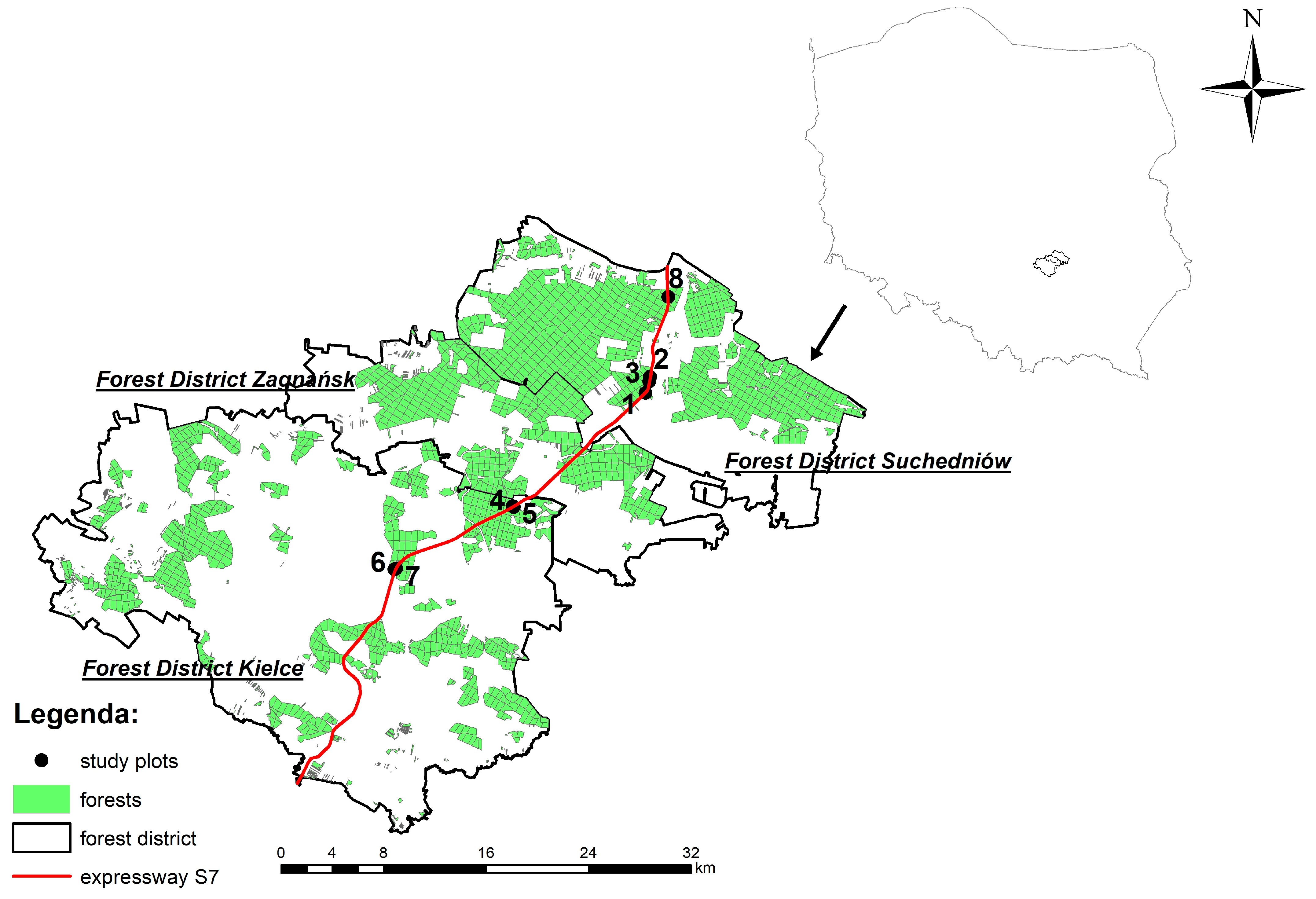
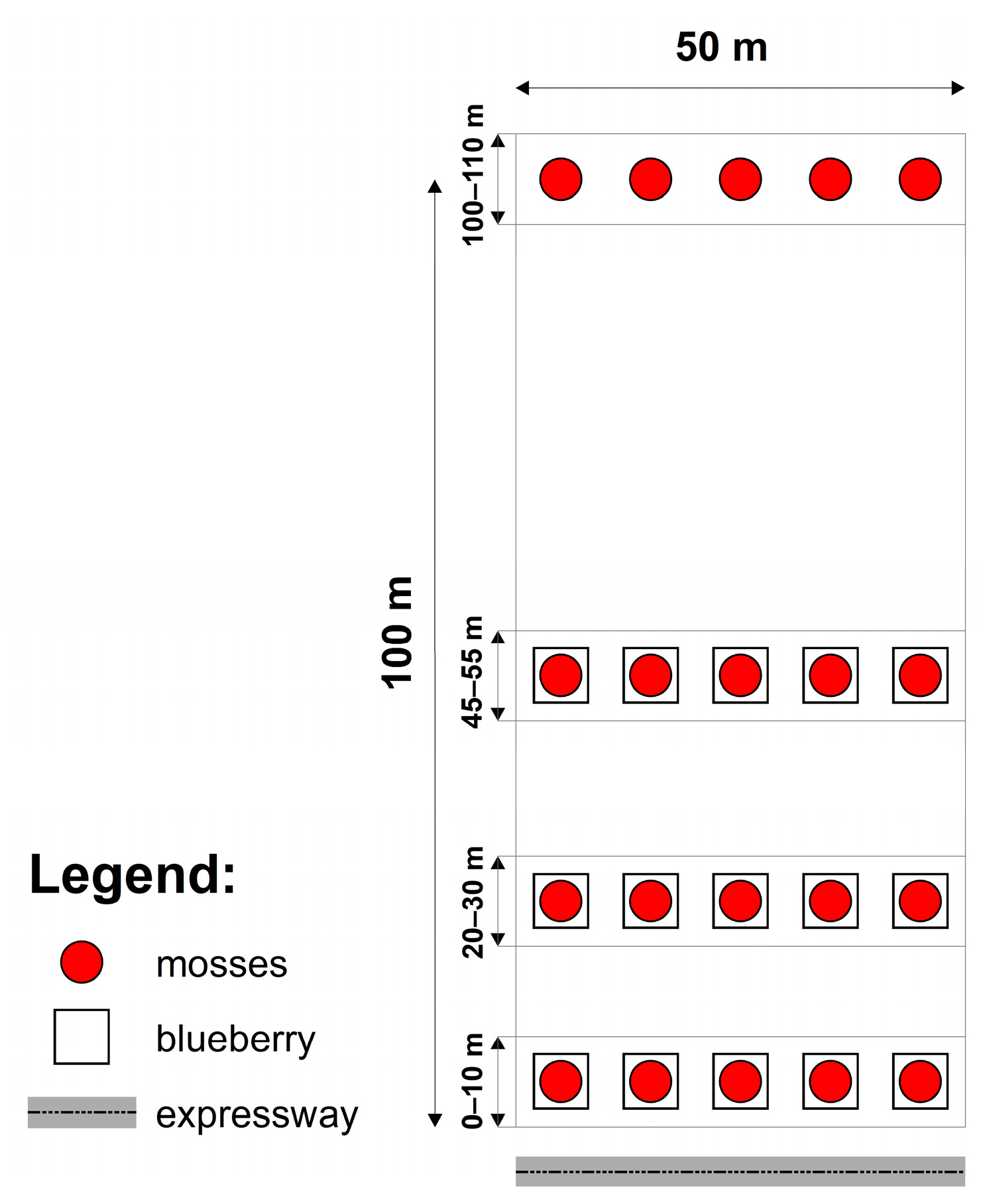




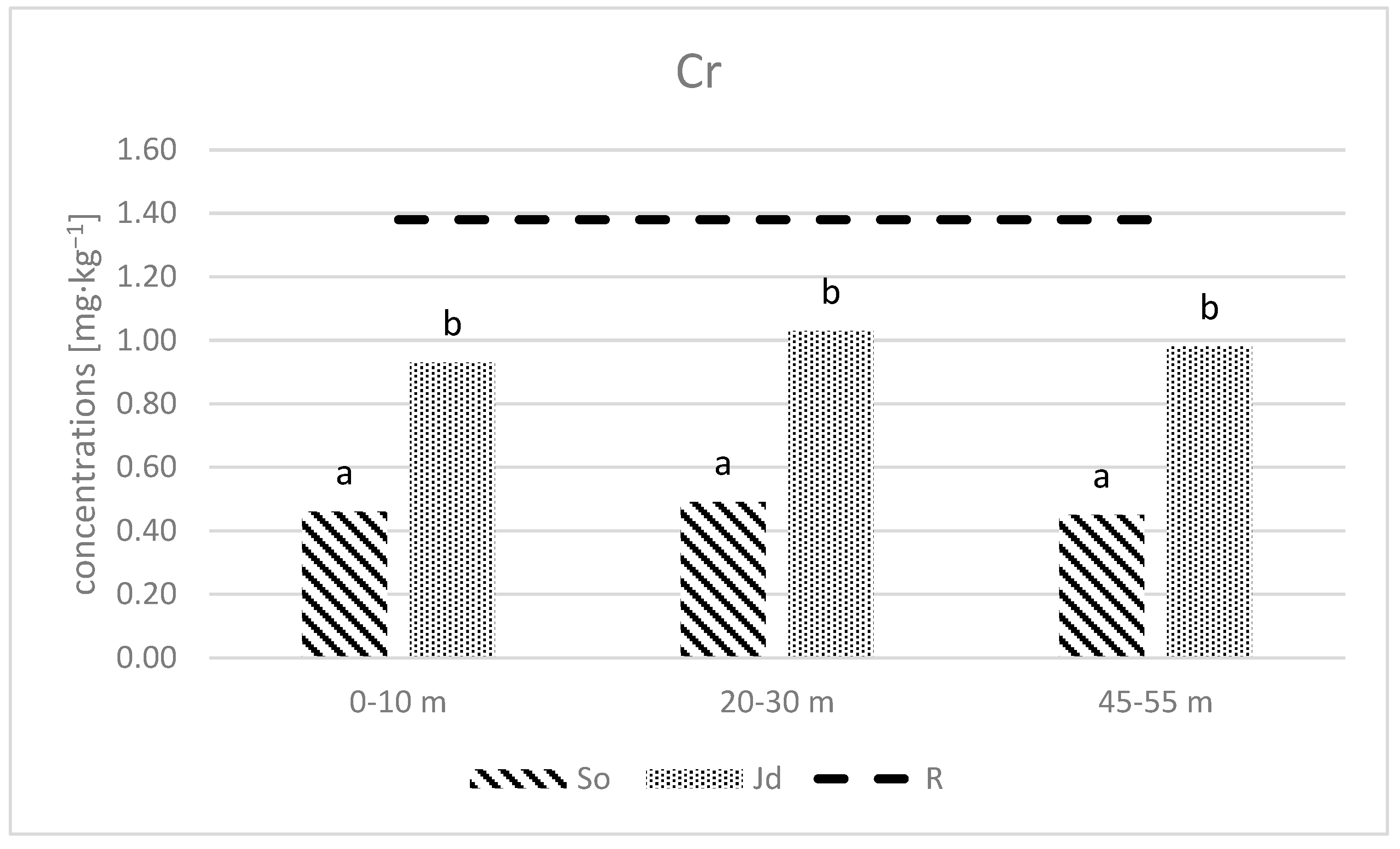
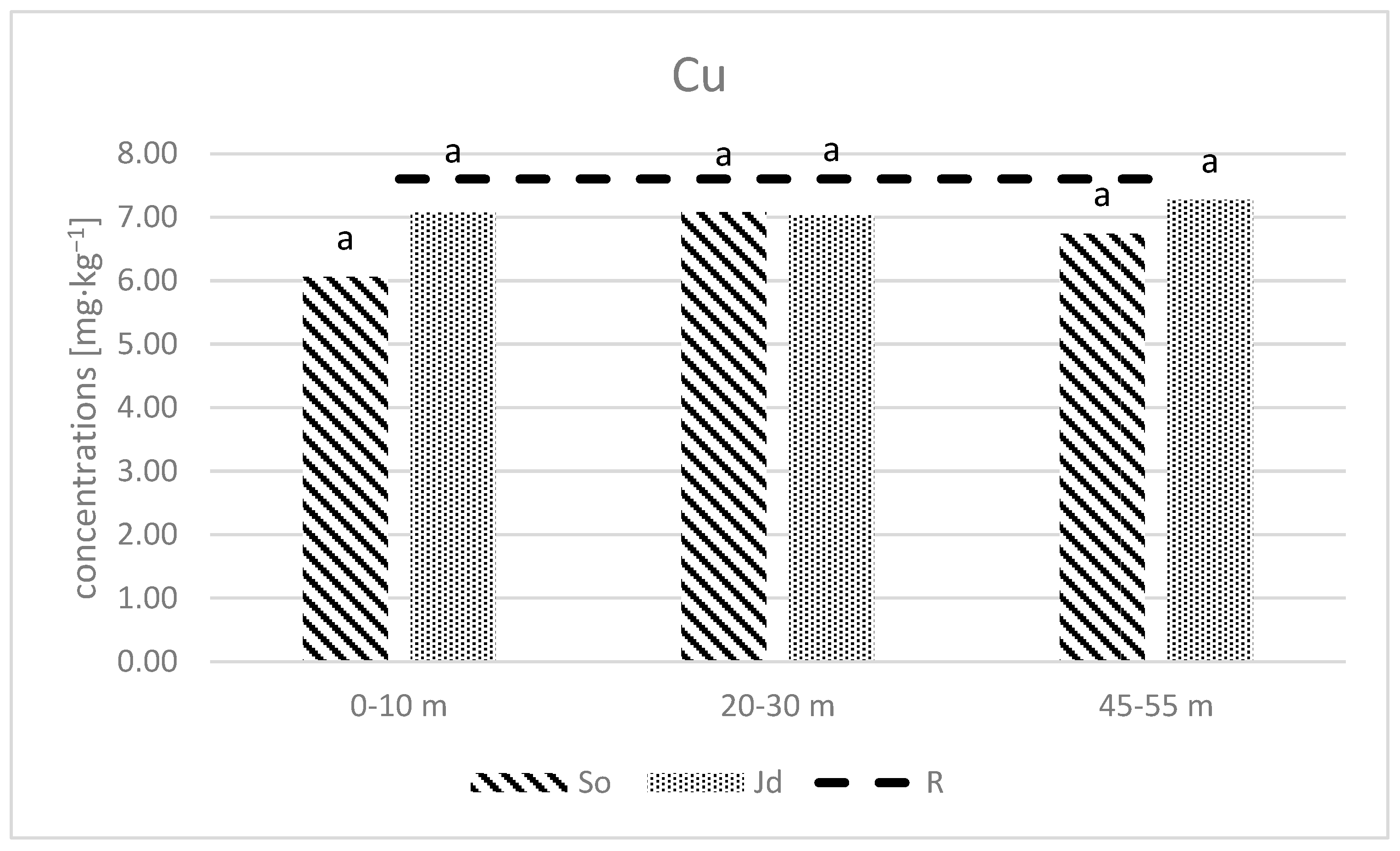
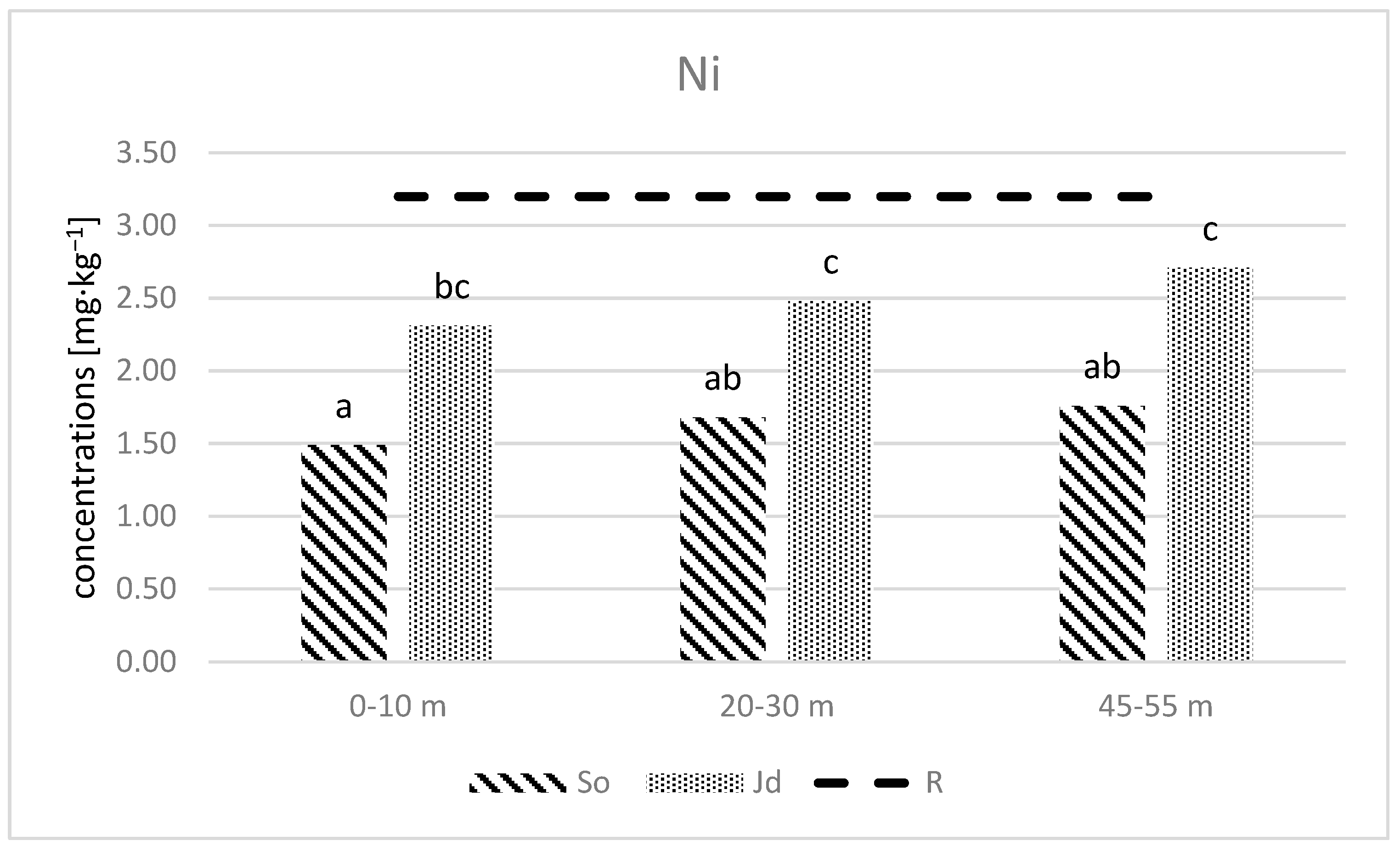

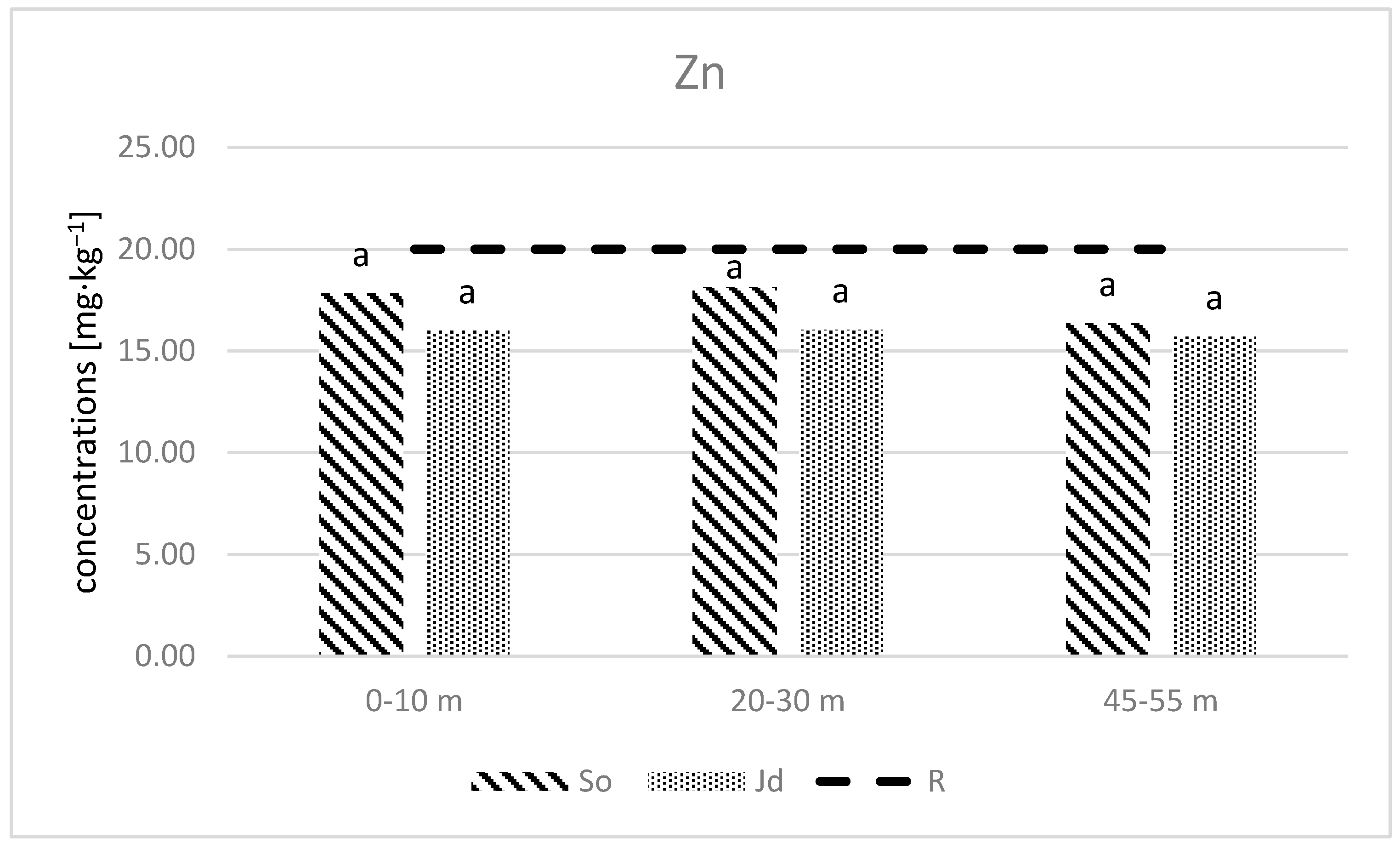
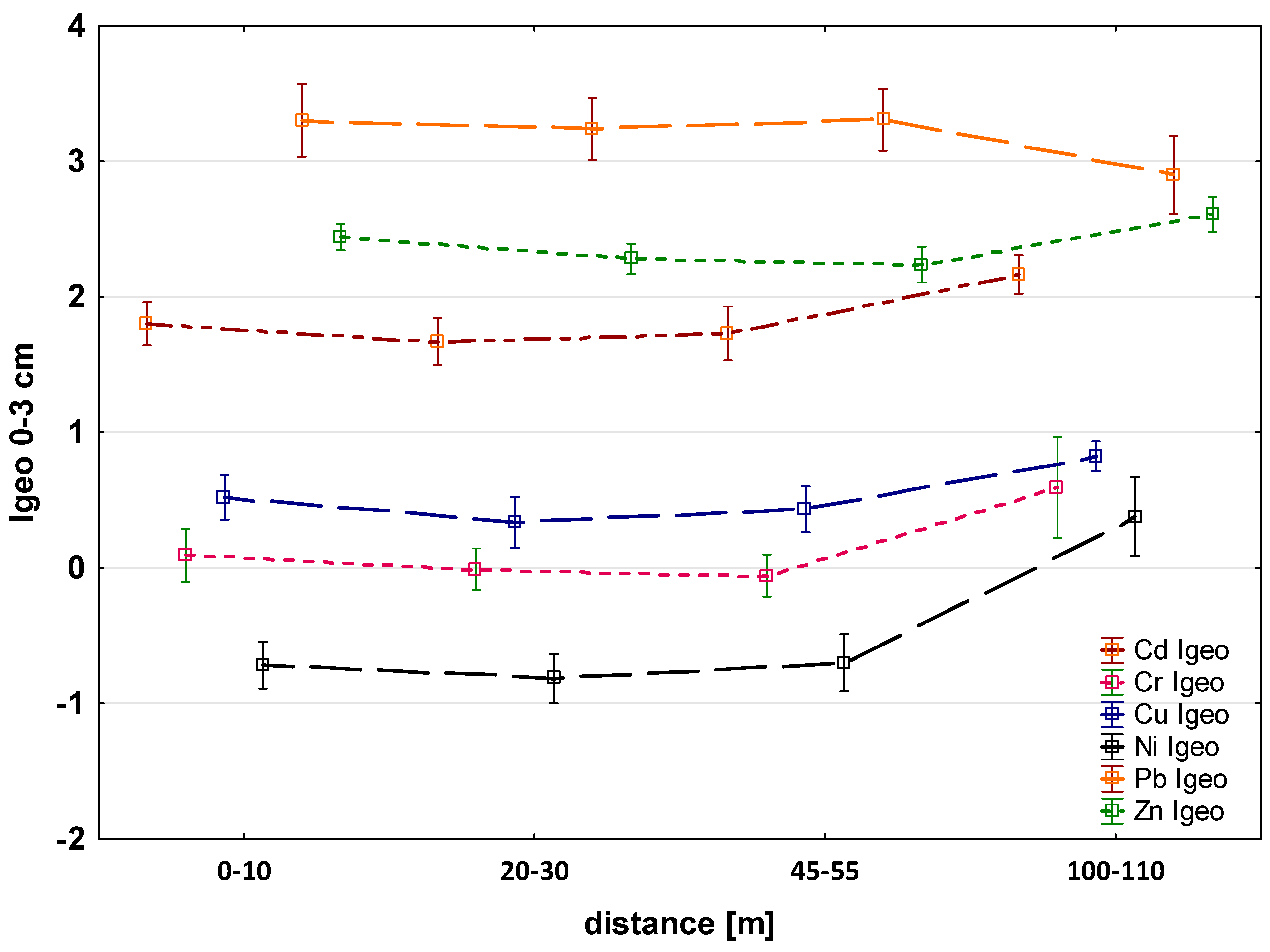
| Element [mg·kg−1] | Species | |||
|---|---|---|---|---|
| Under Fir Stands | Under Pine Stands | |||
| Pollution Deposition Period [Number of Years] | ||||
| 9 | 36 | 9 | 36 | |
| Cd | 0.36 ± 0.09 a | 0.35 ± 0.22 a | 0.28 ± 0.00 a | 0.25 ± 0.04 a |
| Cr | 7.21 ± 6.38 a | 4.68 ± 2.99 a | 3.69 ± 1.42 a | 3.61 ± 1.00 a |
| Cu | 11.25 ± 2.35 a | 13.69 ± 4.45 a | 10.27 ± 2.27 a | 11.25 ± 6.37 a |
| Ni | 3.93 ± 2.62 a | 2.63 ± 1.26 b | 1.84 ± 0.48 a | 1.67 ± 0.37 a |
| Pb | 10.06 ± 4.76 a | 7.65 ± 3.66 a | 7.61 ± 3.58 a | 7.05 ± 2.16 a |
| Zn | 52.85 ± 12.11 a | 57.59 ± 16.84 a | 58.58 ± 7.35 a | 56.46 ± 6.15 a |
| Element [mg·kg−1] | Species | |||
|---|---|---|---|---|
| Under Fir Stands | Under Pine Stands | |||
| Pollution Deposition Period [Number of Years] | ||||
| 9 | 36 | 9 | 36 | |
| Cd | 0.10 ± 0.04 a | 0.10 ± 0.04 a | 0.04 ± 0.02 a | 0.10 ± 0.02 b |
| Cr | 1.10 ± 0.30 a | 0.80 ± 0.14 b | 0.40 ± 0.23 a | 0.60 ± 0.23 a |
| Cu | 7.30 ± 1.30 a | 6.70 ± 0.86 a | 6.40 ± 1.21 a | 7.20 ± 2.51 a |
| Ni | 2.90 ± 0.53 a | 1.70 ± 0.41 b | 1.60 ± 0.59 a | 1.70 ± 0.58 a |
| Pb | 1.30 ± 0.38 a | 0.90 ± 0.16 b | 0.60 ± 0.26 a | 1.00 ± 0.51 b |
| Zn | 16.10 ± 1.77 a | 15.60 ± 1.83 a | 16.30 ± 2.48 a | 20.80 ± 3.59 b |
| Element [mg·kg−1] | Scots Pine | Silver Fir | ||
|---|---|---|---|---|
| Presence of Forest Edge | ||||
| No | Yes | No | Yes | |
| n = 58 | n = 20 | n = 20 | n = 58 | |
| Cd | 0.28 ± 0.07 a | 0.25 ± 0.04 a | 0.41 ± 0.09 a | 0.34 ± 0.19 a |
| Cr | 3.69 ± 1.42 a | 3.61 ± 10 a | 5.86 ± 2.31 a | 5.93 ± 5.74 a |
| Cu | 10.27 ± 2.27 a | 11.25 ± 6.37 a | 12.14 ± 1.72 a | 12.63 ± 4.26 a |
| Ni | 1.84 ± 0.48 a | 1.67 ± 0.37 a | 3.50 ± 1.32 a | 3.18 ± 2.35 a |
| Pb | 7.61 ± 3.58 a | 7.05 ± 2.16 a | 11.74 ± 5.45 a | 7.82 ± 3.45 b |
| Zn | 51.58 ± 7.35 a | 56.46 ± 6.15 b | 56.03 ± 12.53 a | 55.02 ± 15.63 a |
| Element [mg·kg−1] | Scots Pine | Silver Fir | ||
|---|---|---|---|---|
| Presence of Forest Edge | ||||
| No | Yes | No | Yes | |
| n = 58 | n = 20 | n = 20 | n = 58 | |
| Cd | 0.04 ± 0.00 a | 0.06 ± 0.02 b | 0.12 ± 0.03 a | 0.08 ± 0.04 b |
| Cr | 0.44 ± 0.20 a | 0.56 ± 0.23 a | 1.11 ± 0.23 a | 0.87 ± 0.24 b |
| Cu | 6.44 ± 1.20 a | 6.58 ± 0.87 a | 7.56 ± 1.65 a | 6.87 ± 0.76 a |
| Ni | 1.61 ± 0.50 a | 1.74 ± 0.58 a | 2.94 ± 0.50 a | 2.24 ± 0.75 b |
| Pb | 0.60 ± 0.23 a | 0.90 ± 0.20 b | 1.46 ± 0.42 a | 1.02 ± 0.22 b |
| Zn | 16.30 ± 2.48 a | 20.84 ± 3.59 b | 16.29 ± 2.14 a | 15.70 ± 1.57 a |
| Element [mg·kg−1] | Scots Pine | Silver Fir | ||||
|---|---|---|---|---|---|---|
| Position of Surface in Relation to the Road | ||||||
| Equally | Above | Under | Equally | Above | Under | |
| n = 20 | n = 18 | n = 40 | n = 18 | n = 40 | ||
| Cd | 0.22 ± 0.06 a | 0.27 ± 0.04 b | 0.29 ± 0.06 b | Bd 1 | 0.40 ± 0.17 a | 0.24 ± 0.09 b |
| Cr | 2.97 ± 1.45 a | 3.84 ± 1.19 ab | 3.94 ± 1.20 b | Bd | 6.26 ± 5.52 a | 4.91 ± 3.38 a |
| Cu | 11.06 ± 3.05 a | 9.38 ± 0.87 a | 10.76 ± 4.69 a | Bd | 11.74 ± 3.45 a | 14.70 ± 3.87 b |
| Ni | 1.85 ± 0.53 a | 1.83 ± 0.44 a | 1.76 ± 0.43 | Bd | 3.40 ± 2.30 a | 2.86 ± 1.49 a |
| Pb | 5.53 ± 1.56 a | 6.63 ± 1.63 a | 8.81 ± 3.83 b | Bd | 9.45 ± 4.76 a | 7.01 ± 2.21 b |
| Zn | 48.80 ± 7.99 a | 51.42 ± 6.62 ab | 55.48 ± 6.31 b | Bd | 55.30 ± 15.91 a | 55.22 ± 11.47 a |
| Element [mg·kg−1] | Scots Pine | Silver Fir | ||||
|---|---|---|---|---|---|---|
| Position of Surface in Relation to the Road | ||||||
| Equally | Above | Under | Equally | Above | Under | |
| n = 20 | n = 18 | n = 40 | n = 18 | n = 40 | ||
| Cd | 0.04 ± 0.03 a | 0.04 ± 0.02 a | 0.05 ± 0.02 a | bd 1 | 0.09 ± 0.04 | bd |
| Cr | 0.18 ± 0.12 a | 0.54 ± 0.18 b | 0.58 ± 0.18 b | bd | 0.95 ± 0.26 | bd |
| Cu | 7.57 ± 0.77 a | 6.40 ± 1.01 b | 5.94 ± 0.96 b | bd | 7.12 ± 1.19 | bd |
| Ni | 2.13 ± 0.56 a | 1.38 ± 0.49 b | 1.54 ± 0.51 b | bd | 2.49 ± 0.74 | bd |
| Pb | 0.38 ± 0.16 a | 0.58 ± 0.16 b | 0.86 ± 0.18 c | bd | 1.18 ± 0.37 | bd |
| Zn | 14.63 ± 1.70 a | 16.31 ± 2.18 a | 19.40 ± 3.34 b | bd | 15.91 ± 1.79 | bd |
| Element [mg·kg−1] | Scots Pine | Silver Fir | ||||
|---|---|---|---|---|---|---|
| Stand Age | ||||||
| 53 + 57 | 66 | 88 | 65 | 93 + 94 | 113 | |
| n = 40 | n = 20 | n = 20 | n = 20 | n = 40 | n = 18 | |
| Cd | 0.26 ± 0.04 a | 0.22 ± 0.06 b | 0.33 ± 0.06 c | 0.24 ± 0.09 a | 0.43 ± 0.17 b | 0.31 ± 0.07 a |
| Cr | 3.72 ± 1.09 ab | 2.97 ± 1.45 a | 4.27 ± 1.31 b | 4.91 ± 3.38 a | 5.16 ± 2.46 a | 8.71 ± 8.84 b |
| Cu | 10.31 ± 3.62 a | 11.06 ± 3.05 a | 10.28 ± 2.02 a | 14.70 ± 3.87 a | 12.42 ± 3.29 b | 10.25 ± 2.59 b |
| Ni | 1.75 ± 0.40 a | 1.85 ± 0.53 a | 1.85 ± 0.49 | 2.86 ± 1.49 a | 2.95 ± 1.15 a | 4.41 ± 3.54 b |
| Pb | 6.84 ± 1.89 a | 5.53 ± 1.56 a | 10.57 ± 4.36 b | 7.01 ± 2.21 a | 10.01 ± 5.06 b | 8.20 ± 3.01 ab |
| Zn | 53.94 ± 6.38 a | 48.80 ± 7.99 b | 54.5 ± 6.48 a | 55.22 ± 11.47 a | 57.99 ± 16.74 a | 49.31 ± 10.90 a |
| Element [mg·kg−1] | Scots Pine | Silver Fir | ||||
|---|---|---|---|---|---|---|
| Stand Age | ||||||
| 53 + 57 | 66 | 88 | 65 | 93 + 94 | 113 | |
| n = 40 | n = 20 | n = 20 | n = 20 | n = 40 | n = 18 | |
| Cd | 0.05 ± 0.02 a | 0.04 ± 0.03 a | 0.05 ± 0.01 a | bd | 0.11 ± 0.04 a | 0.07 ± 0.02 b |
| Cr | 0.55 ± 0.20 a | 0.18 ± 0.12 b | 0.61 ± 0.11 a | bd | 0.93 ± 0.19 a | 1.03 ± 0.25 a |
| Cu | 6.49 ± 0.94 a | 7.57 ± 0.77 b | 5.35 ± 0.60 c | bd | 7.14 ± 1.26 a | 7.06 ± 0.61 a |
| Ni | 1.56 ± 0.53 a | 2.13 ± 0.56 b | 1.33 ± 0.34 a | bd | 2.34 ± 0.45 a | 2.86 ± 0.58 a |
| Pb | 0.74 ± 0.18 a | 0.38 ± 0.16 b | 0.82 ± 0.16 a | bd | 1.20 ± 0.29 a | 1.13 ± 0.23 a |
| Zn | 18.58 ± 2.88 a | 14.63 ± 1.70 b | 17.96 ± 2.39 a | bd | 15.92 ± 1.98 a | 15.89 ± 1.20 a |
| Element [mg·kg−1] | Mosses | Blueberry | ||
|---|---|---|---|---|
| Fir Stands n = 78 | Pine Stands n = 78 | Fir Stands n = 42 | Pine Stands n = 60 | |
| Cd | 0.36 ± 0.17 a | 0.27 ± 0.07 b | 0.09 ± 0.04 a | 0.04 ± 0.02 b |
| Cr | 5.91 ± 5.07 a | 3.67 ± 1.32 b | 0.98 ± 0.31 a | 0.47 ± 0.23 b |
| Cu | 12.5 ± 3.77 a | 10.52 ± 3.74 b | 7.12 ± 1.19 a | 6.63 ± 1.64 a |
| Ni | 3.26 ± 2.13 a | 1.80 ± 0.46 b | 2.49 ± 0.74 a | 1.65 ± 0.59 b |
| Pb | 8.82 ± 4.37 a | 7.47 ± 3.27 b | 1.18 ± 0.37 a | 0.72 ± 0.38 b |
| Zn | 55.28 ±14.83 a | 52.83 ± 7.34 b | 15.91 ± 1.79 a | 17.44 ± 3.40 b |
Disclaimer/Publisher’s Note: The statements, opinions and data contained in all publications are solely those of the individual author(s) and contributor(s) and not of MDPI and/or the editor(s). MDPI and/or the editor(s) disclaim responsibility for any injury to people or property resulting from any ideas, methods, instructions or products referred to in the content. |
© 2024 by the authors. Licensee MDPI, Basel, Switzerland. This article is an open access article distributed under the terms and conditions of the Creative Commons Attribution (CC BY) license (https://creativecommons.org/licenses/by/4.0/).
Share and Cite
Warczyk, A.; Gruba, P.; Józefowska, A.; Wanic, T.; Warczyk, A.; Świątek, B.; Bujak, J.; Pietrzykowski, M. Accumulation of Heavy Metals in Blueberry (Vaccinium myrtillus L.) and Dominant Mosses (Pleurozium schreberi (Willd. ex Brid.) Mitt.) as Bioindicators of the Expressway Influence on Forest Ecosystems. Atmosphere 2024, 15, 971. https://doi.org/10.3390/atmos15080971
Warczyk A, Gruba P, Józefowska A, Wanic T, Warczyk A, Świątek B, Bujak J, Pietrzykowski M. Accumulation of Heavy Metals in Blueberry (Vaccinium myrtillus L.) and Dominant Mosses (Pleurozium schreberi (Willd. ex Brid.) Mitt.) as Bioindicators of the Expressway Influence on Forest Ecosystems. Atmosphere. 2024; 15(8):971. https://doi.org/10.3390/atmos15080971
Chicago/Turabian StyleWarczyk, Arkadiusz, Piotr Gruba, Agnieszka Józefowska, Tomasz Wanic, Agata Warczyk, Bartłomiej Świątek, Julita Bujak, and Marcin Pietrzykowski. 2024. "Accumulation of Heavy Metals in Blueberry (Vaccinium myrtillus L.) and Dominant Mosses (Pleurozium schreberi (Willd. ex Brid.) Mitt.) as Bioindicators of the Expressway Influence on Forest Ecosystems" Atmosphere 15, no. 8: 971. https://doi.org/10.3390/atmos15080971






